Home »
Peugeot has introduced a new automatic gearbox option for the Peugeot Boxer large van.
The new EAT8 eight-speed automatic transmission is available alongside the six-speed manual gearbox on the 2.2-litre BlueHDi 140 and 180 engine versions of the Boxer.
Buyers can have the option of a Light Duty (Euro 6E) and Heavy Duty (Euro VIE) homologation engine with the new transmission, enable the heavier conversions like motorhomes to be based on the Boxer chassis with a new automatic transmission.
Engines with the EAT8 transmission also get up to 450Nm of torque with the BlueHDi 180 engine which his 80Nm more than the previous manual transmission.
As a result, the Boxer is said to have best-in-class torque in the sector.
Another innovation of the EAT8 automatic transmission is a hydraulic accumulator, which makes it possible to leverage the most from the engine's power by reducing the gearbox response time and promoting the smoother operation of the Start & Stop system.
The overall gross vehicle weight of the Boxer has also been increased to allow for heavier conversions with a new GVW of up to five tonnes.
The Peugeot Boxer is based on the shared Stellantis van platform used by the Vauxhall Movano, Citroen Relay and Fiat Ducato – it’s also sold as the Toyota Proace Max – and is available in two wheelbases (3.45m and 4.04m) with panel vans in two lengths (L2 and L4) and two roof heights giving a load volume of between 13-17m3.
For more on the size of the large Peugeot van read our guide to the Peugeot Boxer dimensions.
The long-wheelbase Boxer is also available as a single cab L3 or L4 chassis, and a double cab L3 or L4 chassis.
Recent changes to the Peugeot Boxer have seen new exterior styling changes that have improved aerodynamic efficiency. The Boxer has gained a new front bumper, grille and mirrors, while on the inside there’s been an overhaul of the cabin along with new driver assistance systems.
Safety equipment now includes an electric parking brake, keyless entry and start, 10-inch central touchscreen, wireless smartphone charging, driver fatigue alert, and automatic emergency braking with pedestrian and cyclist detection.
The Peugeot Expert has one of the best towing capacity ratings in the medium van segment with an unbraked trailer towing capacity of 750kg and a braked trailer towing capacity of 2.5-tonnes or 2,500kg.
The Expert has a good towing capacity compared to other mid-sized vans which has improved over the years. The previous version of the Expert was limited to a 2000kg capacity but the new Expert van gets a much better 2,500kg.
Because of this the towing capacity of the Peugeot Expert is better than rivals but is still a lot less than a large van. If you really want to tow a lot then a pick-up truck is probably the best option or something bigger because the Ford Transit towing capacity is much greater than a medium van.
Incidentally, you can also compare the towing capacity of the medium-sized Ford Transt Custom towing capacity in our helpful guide.
How good the Expert is for towing depends on the engine you have because all Expert vans have the same towing capacity of 2.5-tonnes. Whether you have the Peugeot Expert 2.0 HDI or the 1.6 HDI the towing capacity is still 2500kg.
The Expert comes in 125hp and 145hp versions, so if you intend to pull a trailer at full weight you’re better off with a more powerful engine. That’s not to say the small one is a slouch, but the Expert 2.0 HDI has a better chance of doing the towing job more easily and with less fuss.
You need to consider the vehicles entire weight when finding the towing limit of a van.The gross combination weight (GCW) also referred to as the gross train weight (GTW) affects what you can pull and the Peugeot Expert van towing capacity.
The weight of the van, its payload (even the driver and passengers) as well as the weight of the trailer your towing all contribute to the GCW of the van.
The all important question then is, what is the gross combination weight of the Expert. Thankfully that is a simple answer as all the Expert van models have the same figure. Oh wait, there’s an exception – isn’t there always – the double cab variants have a slight difference.
Double cab variants of the Peugeot Expert have a gross combination weight (GCW) of 5.6-tonnes or 5600kg.
As the GVW is limited to 3100kg for the biggest versions of the Peugeot Expert, when you factor in the overall 2500kg max weight that is permitted of the trailer plus its payload, it means that it is impossible to exceed the GCW even if you have a full payload. Of course you need to not break the rules on the Peugeot Expert payload maximums, or else you’ll not only be in trouble for overloading the van but you’ll have an overweight van and trailer combination too.
So, that’s the general rule for GCW applied to the Expert but there’s a slight variation which goes back to the engine sizes. The Peugeot Expert 2.0 HDI towing capacity is greater the 1.5 HDI engine as it has a lower gross vehicle weight of 2830kg.
That means you’ll need to be aware of the overall Peugeot Expert payload so it’s best to check plates on the vehicle. These can usually be found either inside the door or under the bonnet of the van.
The Peugeot Expert van does not come with a towbar as standard. There is, however, an option for one to be added as a factory option.
The ball and hook tow bar option is available on the Expert for all models which gives you a 13-pin connector plug. It costs around £700 – which is quite punchy for a towbar connector on a van.
Let’s hope you haven’t broken down and that’s why you need to know how to tow the Peugeot Expert. In order to tow the Peugeot Expert van you’ll need to find the towing eye which is the circular loop you’ll attach a towing rope of bar to.
The towing eye location on the Peugeot Expert can be found under the front bumper. It’s to one side of the main chassis arm, so you need to go under the front of the van to look for it.
Once it’s hooked up you need to think about how the rope or bar will press against the bumper when you are towing – you don’t want to cause any unnecessary damage.
The Peugeot Expert panel van can tow 750kg with an unbraked trailer and 2500kg with a braked trailer
Stellantis electric van production site could be at risk, according to Stellantis UK group MD, Maria Grazia Davino.
Ellesmere Port is currently an electrification hub for production of the Citroen E-Berlingo, Fiat E-Doblo, Peugeot E-Partner and Vauxhall Combo Electric.
Speaking at the Society of Motor Manufacturers and Traders (SMMT) annual summit, Davino said the site near Liverpool as well as Vauxhall’s factory in Luton could be in jeopardy if more wasn’t done by government to increase demand for zero emission vehicles.
The decision to halt production at one or both sites could come as soon as a year.
Davino said: “Stellantis UK does not stop, but Stellantis production in the UK could stop.”
Electric van production is due to start in Luton next year when it will make the medium sized electric vans in the group which include the Citroen E-Dispatch, Fiat E-Scudo, Peugeot E-Expert and Vauxhall Vivaro Electric.
“We have undertaken big investments in Ellesmere Port and in Luton, with more to come. If this market becomes hostile to us, we will enter an evaluation for producing elsewhere,” Davino explained.
The UK government has set a goal to ban sales of new petrol and diesel cars by 2035 - initially their plan was to introduce the ban in 2030.
With all parties currently on the campaign trail ahead of the 4 July general election, key climate change messages and how future governments will tackle them have become an important manifesto element.
Increasing threats from the EU to impose tariffs on Chinese built vehicles is also causing unrest in the industry.
After an EU indication that costly tariffs could be imposed on Chinese manufacturers - that would include Maxus and models including the recently launched Maxus eDeliver 5 and Maxus eDeliver 7 - several European manufacturers chastised the idea, including global Stellantis boss Carlos Tavares.
It may sounds like a simple question to ask who owns Peugeot, but as one of Europe's oldest car manufacturers there are lots of interesting facts associated with the history of Peugeot ownership.
Answer the question....
The current owner of Peugeot is Stellantis, the combined company of PSA Group and Fiat Chrysler Automobiles created on 16 January 2021.
If you want to know more about the owners of Peugeot, then there's a seperate article all about this new global automotive powerhouse, called Who is Stellantis? in our advice section.
The Peugeot name is steeped in history. Life began making coffee grinders and bicycles, using the family expertise in making cog-based items the natural step was to bring that knowhow into gears for a car. In 1896 Armand Peugeot branched out from the family business to set up a new car company with the same name. The rest, as they say, is history, as Peugeot Cars became a roaring success
Peugeot grew into one of the largest car manufacturers riding out storm of two world wars to become France's best-loved manufacturer.
Peopele often get confused about the nature of how Peugeot and Citroen became a duo.
The marriage between France's two biggest auto makers happened in December 1974 when Peugeot bought a 38.2% share of Citroen.
Less than two years later, in April 1976 they took a controlling stake of 89.95% when Citroen went bankrupt.
This brought about the formation of PSA Group, which is short for Peugeot Société Anonyme. Henceforth, and up until the merger with Fiat Chrysler it was then known as PSA Peugeot Citroën.
The first Peugeot van dates back to the time of the formation of the Peugeot automotive business with the Type 13 delivery van, offering a 500kg payload and a motorised alternative to a horse and cart.
After WW1 the Peugeot van range began on its path towards the vans we know and love today with its first "car-derived" van - that's to say it was a car with no back seats and therfore suitable for carrying load items.
Later pre-war models took on the appearance of a pick-up truck with a flat load bed and boxy cabin for two occupants.
It was only after WW2 that the typical van dimensions started to take shape with the first front-wheel-drive panel vans. The D3A became the D4, the D7 and then then J7 and J9.
Into the 80s and the Peugeot model names that we now associate with their range started to appear. The Peugeot Boxer made its first apperance, offering a considerable upgrade in carrying capacity over the previous vans. It's also where the association with co-developed Citroen vans began as the two companies shared this new model, known as the Sevel van ((Société Européenne de Véhicules Légers SA and Società Europea Veicoli Leggeri-Sevel S.p.A.) because of its partnership with Fiat.
Stellantis ProOne was created towards the end of last year to symbolise the unification of the many Stellantis brands that now exist under its commercial vehicle umbrella. Citroen, Fiat, Peugeot and Vauxhall brands are now all built off shared platforms producing an unparalleled number of vehicles. With small, medium, and large models from four brands as well as internal combustion engine (ICE) and electric powertrains, there’s 24 individual models. Now, all of them which have been refreshed in some way, simultaneously in an unprecedented renewal of their light commercial vehicle line-up.
But the models aren’t just limited to battery electric vehicles (BEV) and diesel (and some petrol) engine models. Stellantis has also been working on incorporating hydrogen fuel cells into its van range with a mid-sized van available in France and Germany since 2022. Built as a manual conversion, off the production line, the medium-size hydrogen (built as the Vauxhall Vivaro-e Hydrogen) has enjoyed a degree of commercial success but has helped inform the production of an additional model on the large van platform chassis. Due to payload and range compromises for large BEV vans, hydrogen makes considerably more sense, increasing range, reducing “refilling” time compared to EVs and maintaining payload – all while being zero emission. Despite a slow proliferation of hydrogen filling stations across Europe, a European Commission roadmap to create refuelling points within 200km of each other across the entire network of major EU roads will enable hydrogen vans to become viable for many more customers.
However, creating a hydrogen vehicle using an existing platform is not a straightforward process. Renault-owned Hyvia has opted to install its hydrogen tanks on the roof for its first-generation van in an effort to become first to market with a large fuel cell LCV. While the next generation Renault Master (deliveries for which will begin later this year) will enable hydrogen fuel tanks to be incorporated into the chassis, Stellantis have managed to modify the configuration of their mid-sized van’s fuel cell system into the larger model thanks to its renowned ability to work for conversions – largely in the campervan segment.
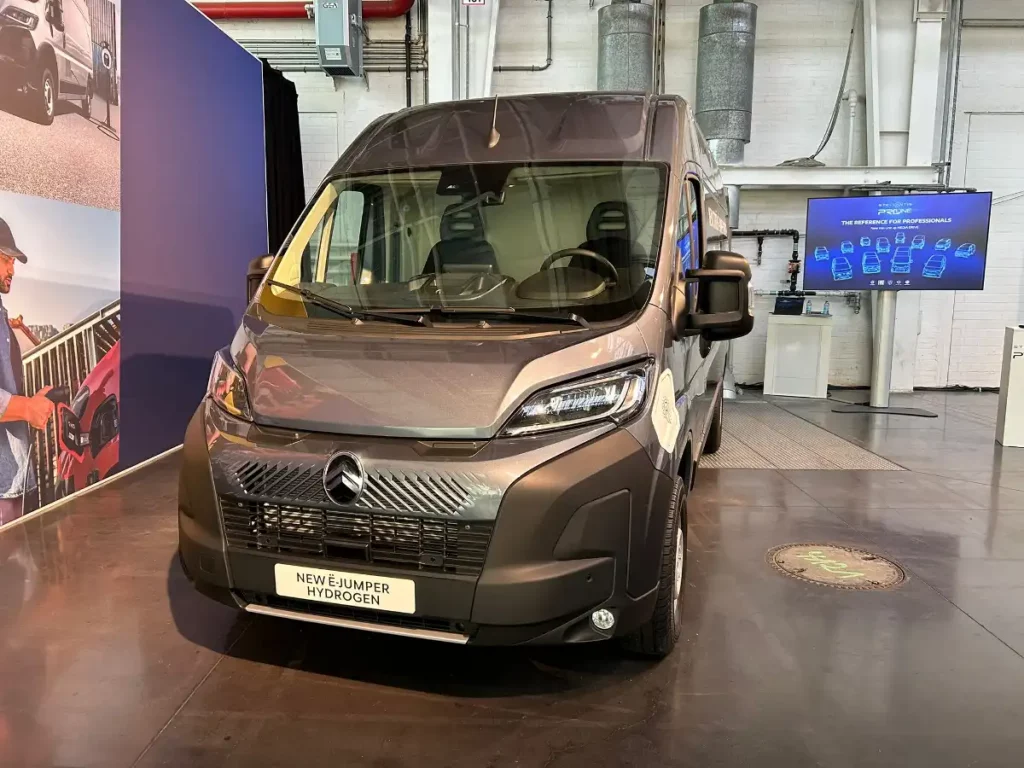
“The installation of the fuel cell system was more challenging than in the mid-sized van,” explains Stellantis hydrogen programme chief engineer, Peter Gross.
“The large van in terms of interior to exterior dimension is best in class, there’s’ nearly no empty packaging space left, so that is why the package looks quite different to the medium-sized van,” he explains.
While both medium and large vans are based on their BEV siblings. The large hydrogen vans will be available using the Citroen E-Relay platform, as well as the Fiat E-Ducato, Peugeot E-Boxer and Vauxhall Movano Electric. The medium van hydrogen fuel cell is based on the Citroen E-Dispatch, Fiat E-Scudo, Peugeot E-Expert and Vauxhal Vivaro Electric, all of which used the space under the bonnet to stack the fuel cell on top of the electric motor used to drive the front wheels. Gross explains that in the larger version this didn’t work, prompting his team to look elsewhere. They opted to use the location previously utilised by the large van’s diesel tank, located under the front seat.
“Package space was found under the front seat, there is a large diesel thank that has been removed and with some modification of the sheet metal there was a chance to put the high voltage battery and the fuel cell stack into this space.”
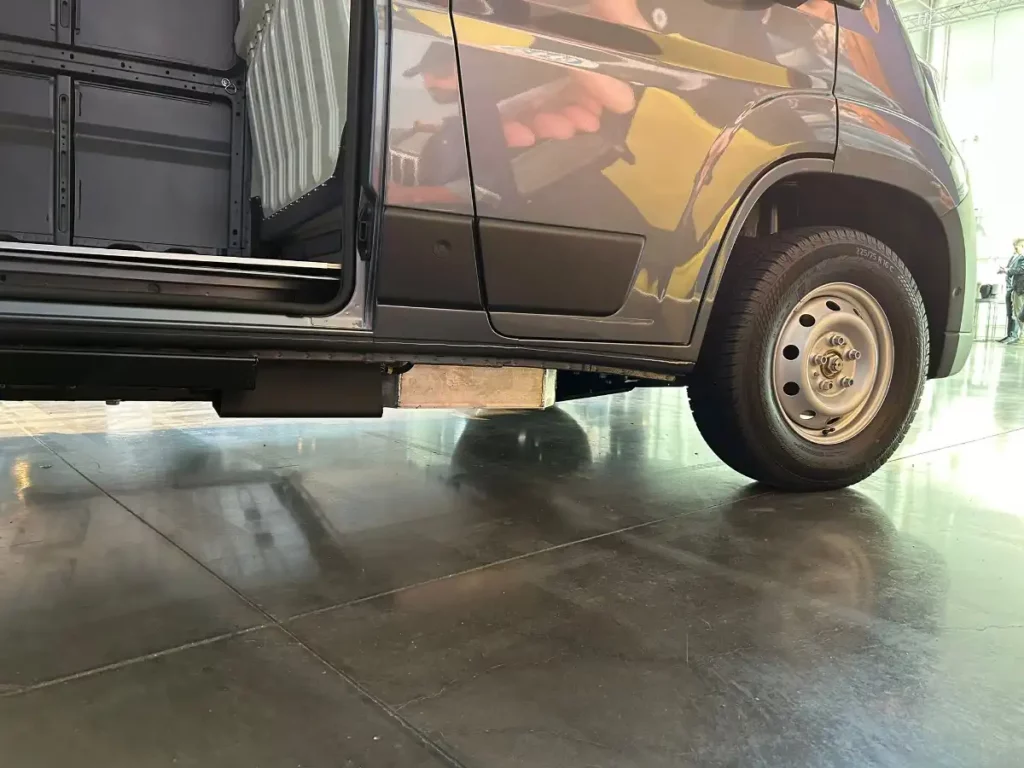
The new location has mean that the air filter now sits in the front of a van, feeding air to a cathode just behind it that is linked by pipework to the fuel cell under the seats. Hydrogen is then fed into the fuel cell from the tanks located in the rear of the van between the chassis rails. Power is then either used for propulsion or stored in the battery underneath the fuel cell. Apart from the layout, there’s also one other significant difference between the medium and large vans.
“In the mid-sized van the battery was actually in the interior of the vehicle, but in the large van it’s in the floor with the other [components],” Gross explains. The result is an easier and more logical installation that, unlike the medium-sized van, will enable the large hydrogen van to come as a right-hand-drive van as early as next year. Unfortunately, the same isn’t true of the mid-sized van. Despite Stellantis launching the van more than a year ago and having moderate success in France and Germany – two countries with a relatively established network for hydrogen refuelling – it is only now just being rolled out to additional markets. The Netherlands, Belgium and other countries in western Europe all feature on the product plan, however, the UK will not for this generation of vehicle. Gross says that it will take a few years for the medium van to be available in right hand drive with a fuel cell, which will be for the next generation of van.
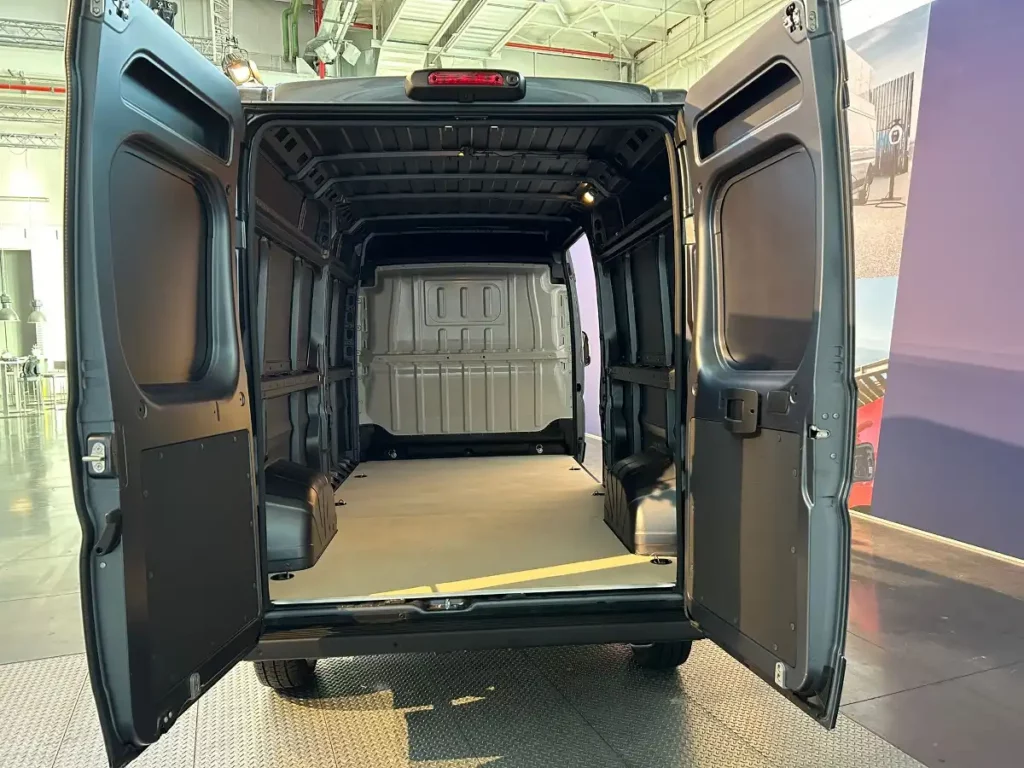
On the other hand, the large van was “considered from the very beginning” according to Gross due to our well-developed home delivery and courier services. While the UK doesn’t have a public infrastructure capable of supporting private use of hydrogen fuel cell vehicles, Stellantis is clearly expecting some private businesses to invest.
“It’s well known that the UK is very open to alternative fuels and the fuel cell proposition,” Gross explains.
“The medium van, will not come as right hand drive in the next few years. It will come with the next generation. Physical constraints are always an issue if you take an existing vehicle and want to install fuel cell components you have to live with certain restrictions,” he adds.
Despite no right-hand-drive hydrogen medium vans, Gross says they’re growing in popularity. They’ll also greater visibility later this year when being used as passenger vehicles around Paris during the Olympics.
“The market demand is growing, and it’s important to have these products available to give customers options. There is no other OEM offering mid-size and large hydrogen vans. With the European Highway, the door will be open to use these vehicles all over Europe,” Gross says referring to the EU’s hydrogen road map.
With hydrogen uptake and infrastructure being such a chicken and egg scenario, building a viable product is the best solution manufactures can have. That’s why Gross says considerable effort was made to ensure that as much hydrogen was able to be carried as possible. The addition of a fourth tank, compared to the medium van’s three, makes the large van a much more usable prospect for the fleets that are likely to be the primary buyers. That capacity, however, was only possible due to the large van’s innate ability carry payload. Luca Marengo, Stellantis commercial vehicles head of global product, attributes that to the van’s design and long standing success as a converted vehicle.
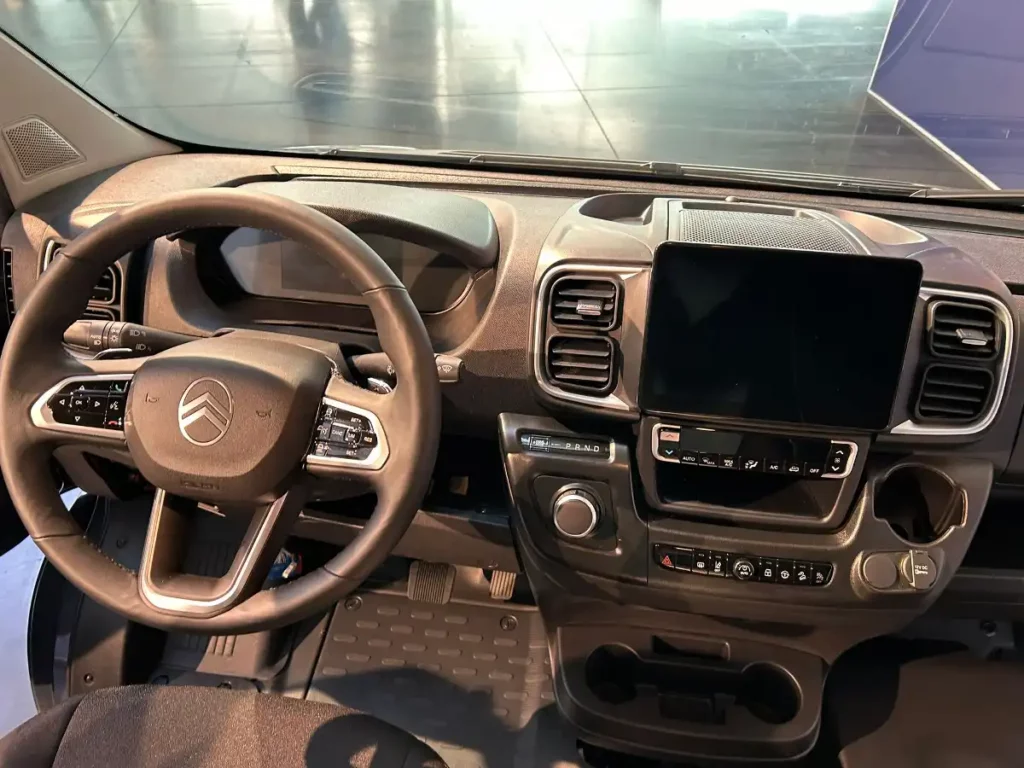
“The Ducato and these [large Stellantis] vans have always been popular with conversions, particularly motorhomes. Storing clean and waste water is something they have always done. That has helped with the space in the chassis for the hydrogen,” Marengo explains.
Ultimately the market will decide how much of a success hydrogen vans will become, but with large vans and fleet customers, they stand a fighting chance. The scalability of the design will also help with a powertrain used across medium and large vans, there’s hope that like electric motors and modular battery packs, volumes will reduce the price and bring hydrogen to the mass market.
Stellantis is one of the world’s largest car manufacturers, created in 2021 with the 50:50 merger of PSA Group Peugeot-Citroen and Fiat Chrysler Automobiles. They are amongst the largest vehicle manufacturers in the world with ambitions to become the largest.
As a result of the Stellantis buyout, the newly formed Stellantis company suddenly found itself with a lot of different owners including majority shareholders of both previous companies – namely the Peugeot family of France and the Agnelli family from Italy.
Fiat Chrysler Automobiles (FCA) was largely owned by the Agnelli family and as such took a majority stake in the new company through its business, Exor. As majority owners of PSA Group (Peugeot-Citroen), the Peugeot family also took a sizeable share in the business, as well as investment arms for the French government, Bpifrance. Additional shareholders include Chinese vehicle manufacturer Dongfeng Motor Corporation.
The resulting company was listed on the Milan and Paris Stock Exchanges as well as in America on New York Stock Exchange (NYSE) where it uses the ticker $STLA for trading.
Stellantis is technically registered and headquartered in The Netherlands. Officially, the business headquarters of Stellantis NV is located in Amsterdam, The Netherlands, with its corporate office in Taurusavenue 1, 2132 LS, Hoofddorp, The Netherlands.
Functionally, there are actually several bases of operation including Milan, Paris and Detroit. This is a result of the merging of many of the corporate entities into Stellantis and their own headquarters. Considerable cost-cutting, however, has seen a number of premises sold or the leases lapse. Perhaps most famous of all is the Lingotto building, once the headquarters of Fiat. Lingotto is most famous for its rooftop test track, immortalised in The Italian Job film. The Lingotto test track is now closed, but it is still walkable on foot. A portion of the rooftop is now used as an outside dining area for a restaurant. The iconic banked section of the Lingotto roof top test track is, however, still used for advertising and commercials. Stellantis no longer owns the Lingotto building.
The Stellantis companies are the merged parts of the PSA Group and Fiat Chrysler Automotive.
Under the merger of the two companies a huge number of iconic names came together. The full number of Stellantis brands now totals 14 car companies, with many other names consigned to the history books. So, what brands are Stellantis? The current Stellantis brands of active car companies is Arbarth, Alfa Romeo, Chrysler, Citroen, Dodge, DS Automobiles, Fiat, Jeep, Lancia, Maserati, Opel, Peugeot, RAM and Vauxhall. There are also additional non-manufacturing brands related to finance and mobility. These are Free2move and Leasys.
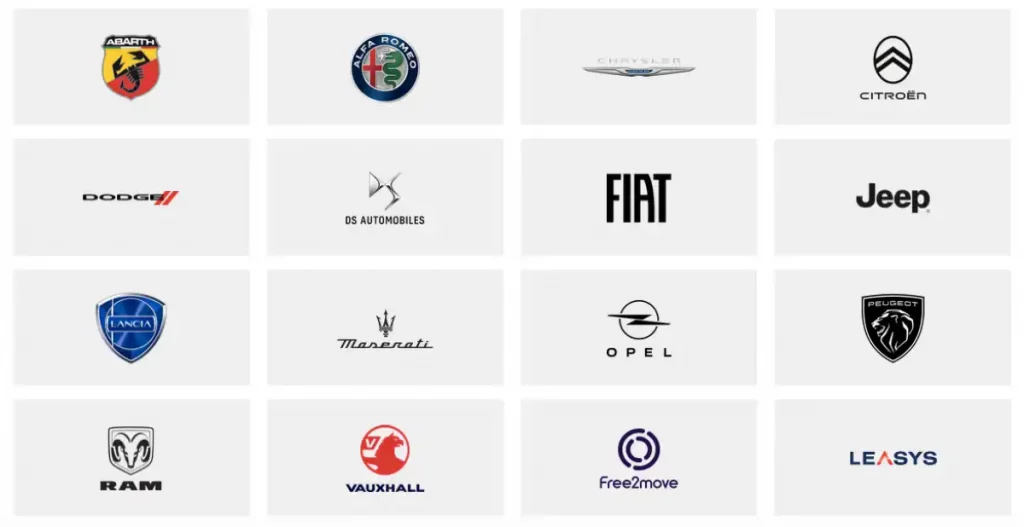
The Stellantis logo, unveiled at the launch of the company, is the world Stellantis in capital letters. The A in the centre of the word is surrounded by a circular sea of stars, while the central horizontal line of the A is also missing which makes the converging lines look like a road. The name is said to come from the Latin verb ‘stello’ which means adorned with stars.

The Stellantis CEO is Carlos Tavares. Tavares (pictured) is an accomplished automotive sector businessman, having previously been PSA Group CEP and President of the managing board. Tavares is known to be a shrewd businessman with a keen key for cost cutting and leveraging economies of scale. There have inevitably been a few Stellantis layoffs as a result of the merging of functions under the new company.

The Stellantis Chairman is John Elkann, heir to the Agnelli empire and a notable Italian businessman and industrialist. He is the CEO of Exor, part-owner of Stellantis, with controlling stakes in Ferrari, CNH Industrial (makers of Case New Holland tractors) and Iveco Group (makers of Iveco vans and trucks).
Announced in 2023, Stellantis Pro One is the collective name for the commercial vehicle brands within the Stellantis group of companies. Stellantis Pro One brands include Citroen, Fiat Professional, Opel, Peugeot, RAM and Vauxhall. Stellantis Pro One builds vans and other light commercial vehicles including pick-up trucks, software solutions for telematics and vehicle tracking, as well as manufacturing white label products for partners like Toyota vans.
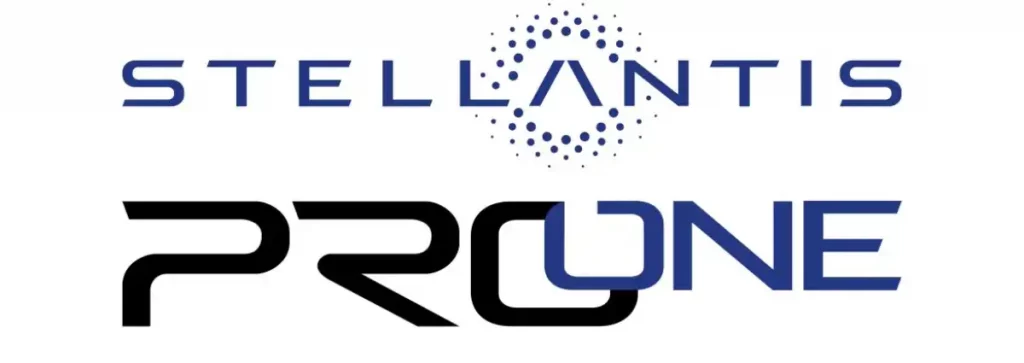
Stellantis currently makes more than 100 individual models in Europe alone with many more in markets across the world. Stellantis brands are sold in more than 130 countries.
Stellantis has the largest van product range of any automotive manufacturer. You've come to the right place to find out about them all too. The vans that Stellantis make currently includes the Citroen Berlingo, Fiat Doblo, Opel Combo, Peugeot Partner, Vauxhall Combo, Citroen Dispatch, Citroen Jumper, Fiat Scudo, Opel Vivaro, Peugeot Expert, Vauxhall Vivaro, Citroen Relay, Citroen Jumpy, Fiat Ducato, Opel Movano, Peugeot Boxer, RAM Promaster and Vauxhall Movano. There are also electric versions of each of those models, as well as passenger van versions of the car-derived vans, chassis cabs, Luton vans and other derivatives.
No. But, one of the Stellantis owners does. Ferrari was part of the Fiat empire owned by the Agnelli family. Its historic name, however, carried so much clout that it was separated from the Fiat Chrysler Automobiles group of companies in order to strengthen it and increase profits. Therefore, Stellantis does not own Ferrari, but Stellantis shareholder Exor (run by Stellantis Chairman John Elkann) does.
Yes. Jeep was one of the Chrysler brands brought into the Fiat Chrysler Automobiles group when the Detroit manufacturer hit the skids in the global financial crisis of 2008.
Yes. Dodge was another one of the Chrysler-owned names that Fiat acquired when it bailed out the American giant and took it out of Chapter 8 bankruptcy.
Yes. Maserati has long been part of the Fiat Automobile Group and along with its famous Italian sibling Alfa Romeo was part of the companies merged into the creation of Stellantis.
Yes. Stellantis owns Fiat as part of the new structure of the combined companies of Fiat Chrysler and PSA Peugeot-Citroen.
Yes, Chrysler became a part of Stellantis as part of the merger of Fiat Chrysler Automobiles and PSA Group.
No. Despite a significant number of its sales, production and even brand names being of American origin, the Stellantis company is technically Dutch and is incorporated in The Netherlands. Stellantis does contain American car brands Dodge, Jeep, RAM and Chrysler.
Stellantis has production sites in 29 countries, and sells vehicles in more than 130 countries. The number of employees on the payroll is said to be in the region of 400,000 people.
Stellantis ProOne’s new hydrogen large van will come in right-hand-drive as early as next year.
Unlike the mid-sized version of their hydrogen fuelled van – currently available in France and Germany as the Vauxhall Vivaro-e Hydrogen – the large van will be based off the Citroen E-Relay, Fiat E-Ducato, Peugeot E-Boxer and Vauxhall Movano Electric battery electric vans. It uses a combination of a 110kW motor paired to a 45kW fuel cell with an 10.5kWh battery pack.
Hydrogen storage is from four vessels providing a total of 7kg of usable H2 and an expected range of more than 500km.
In comparison, the mid-sized van uses three vessels to give the van a 400km range.
The van will be available in L3H2 and L4H3 sizes giving a total loadspace of 13m3 and 17m3 as well as a 1,300kg payload.
The large van can be fuelled at 700 Bar enabling a fill-up time of less than five minutes.
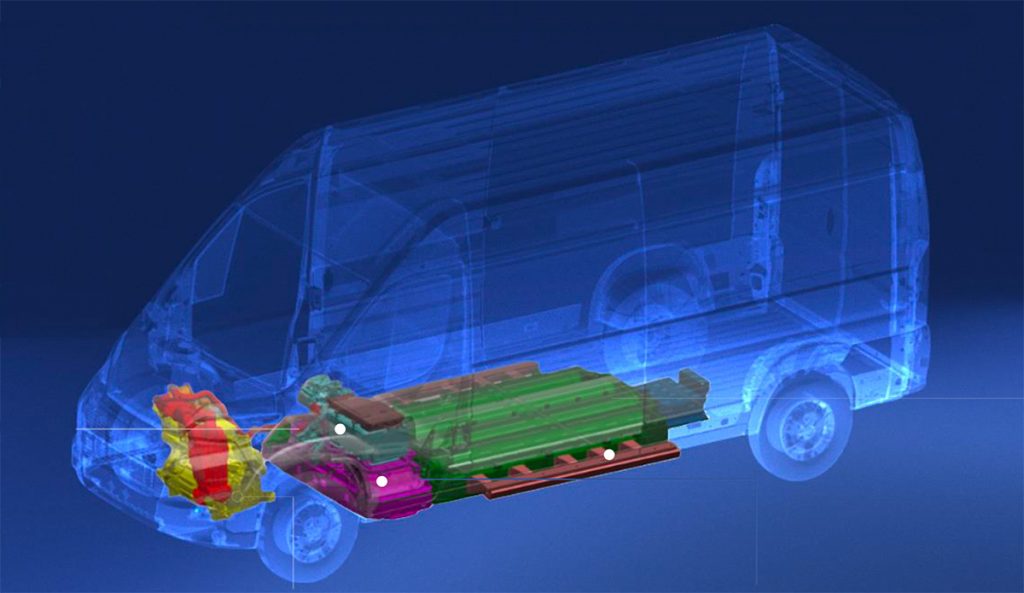
Stellantis’ decision to increase their efforts into hydrogen products are reflected in the EU Council’s decision to create the Alternative Fuels Infrastructure Regulations (AFIR). All EU countries will be required to deliver a viable hydrogen refuelling network with one 700 Bar hydrogen station located every 200km on all main corridor routes. They will also have to have 1 station for each assigned urban node in order to aid refuelling in cities. EU countries will need to have completed the network by 2030 which should create more than 500 filling stations across the EU member states.
Currently there are around 150 public H2 filling stations with the majority in Germany, France, Netherlands and Switzerland.
While the mid-sized H2 van is scheduled to be rolled out to more European countries this year, including Netherlands and Belgium, a right-hand-drive version for the UK will not come until the next generation of medium sized vans is introduced in several years time. Instead, the large van will be rolled out across Europe and to North America after 2025 when a hydrogen fuelled pick-up truck – under the RAM brand – will also be brought to market.
In a major boost for the town, Luton will begin production of new electric models next year for the entire range of Stellantis medium vans sold in the UK.
The plant will mostly be producing right-hand-drive versions of the Stellantis range of vans that include the Vauxhall Vivaro Electric, Peugeot E-Expert, Citroën ë-Dispatch and Fiat Professional E-Scudo. However, the site will also be used to produce some left-hand-drive versions of the same models for export as well as the Opel Vivaro Electric.
Production will begin in the first half of 2025 in limited numbers, and the electric vans will be produced alongside their internal combustion engine counterparts.
Luton joins Ellesmere Port as the second electric model manufacturing site for Stellantis vans in the UK.
Ellesmere Port was announced as the manufacturing site for all versions of the Citroen e-Berlingo, Peugeot e-Partner, Fiat e-Doblo and Vauxhall Combo Electric in September last year, following a £100m investment to transform the plant for EV production. It is also became the first Stellantis plant globally to be dedicated to electric vehicle manufacturing.

Stellantis is currently the best-selling van manufacturer in Europe with a 30.4% market share in 2023. Their electric vehicles also have a 38.8% of the European market, while in the UK that figure rises to 47.9%. Vauxhall was the best-selling electric van manufacturer with 6,402 sales out of Stellantis' total UK sales of 10,272 vans. The majority of Vauxhall's electric van sales were for the Vivaro Electric as the number one electric van in the UK.
Vauxhall's Luton plant began life in 1905 and have been producing the Vivaro van since 2001. When Stellantis acquired Vauxhall and production was switched over from producing Renault-based vans to the Peugeot-Citroen model, the plant also took on group production of medium-sized vans, adding the Fiat Scudo in 2022.
Mark Noble, Luton Plant Director & Stellantis UK Manufacturing Lead, said: “Following the transformation of our Ellesmere Port facility to produce all-electric compact vans, I’m pleased to announce that we will commence limited production of our medium electric van in Luton from next year, when the first customer vehicles will roll off the production line. This is a fitting way to mark Luton’s 120th anniversary.”
Luton produced more than 90,000 vans last year, all of which were ICE models.
Stellantis, makers of Citroen, Fiat, Peugeot and Vauxhall vans, has officially opened the UK’s inaugural Green Automotive Hub, designed to bolster electric van production at its Ellesmere Port manufacturing facility.
Situated at Queen Elizabeth II Eastham docks in Merseyside, the Green Automotive Hub is the result of a collaborative effort between Stellantis, Suardíaz, and Peel Ports. The hub is specifically designed to facilitate maritime logistics service, streamlining the supply of parts to Ellesmere Port, the UK’s first EV-exclusive volume manufacturing plant.
The ribbon-cutting ceremony marked the official opening of the Green Automotive Hub as it welcomed a vessel from Vigo Port in Spain, the location of Ellesmere Port’s sister plant.
The maritime route spanning 891 nautical miles aims to significantly reduce annual CO2 emissions by 30% and slash energy consumption by 37% when compared to traditional road travel. This initiative aligns with Stellantis’ Dare Forward 2030 commitment to achieving carbon neutrality globally by 2038. Additionally, the route is anticipated to eliminate approximately 14,700 lorry journeys annually across the UK and continental Europe, covering an estimated distance of 17.5m kilometers (approximately 11 million miles).
Each ship servicing the route can accommodate up to 95 lorries, transporting around 47 different part lines of sheet metal components crucial for the assembly of all-electric compact vans at Ellesmere Port. The return journey sees the packaging used for parts transported back to Vigo Port for reuse, highlighting a commitment to sustainability.
A combined investment of £10 million from Peel Ports and Suardíaz was dedicated to recommissioning a berth at Queen Elizabeth II Eastham dock, along with installing the necessary infrastructure for processing Roll-on Roll-off (RoRo) ships and their cargo.
Ellesmere Port, recognised as the UK’s premier EV-only volume manufacturing plant, officially commenced electric van production in September following a £100 million investment to transform the facility.
The plant currently produces small vans under Vauxhall Combo Electric, Peugeot E-Partner, Citroën E-Berlingo, and Fiat E-Doblo models, with plans to expand production to include a range of electric passenger vehicles across Stellantis ProOne brands from 2024.
The newly formed Stellantis Pro One division of manufacturers Citroen, Fiat Professional, Opel, Peugeot and Vauxhall, has revealed the complete overhaul of its compact, mid-size and large commercial vans.
In total thare are 12 vehicles new vehicles adopting a new range of electric drivelines, improved safety features, more ADAS and greater connected tech.
“This second generation of zero-emission vans, in line with customer expectations and offering increased BEV autonomy, additional fuel-cell offer, 18 ADAS, full connectivity, and innovations such as ‘electric Power Take Off’, will reinforce even further our current leadership in BEV vans and in all van segments,” said Xavier Peugeot, senior vice president, Stellantis Commercial Vehicles Business Unit.
The most notable change is to the line-up of the large vehicles that have been electrified with a new in-house built driveline. Previously, and prior to the merger of Fiat Chrysler (FCA) with Peugeot-Citroen (PSA), the Fiat e-Ducato used its own electric motors and systems, while the large Peugeot Boxer and Citroen Relay, as well as the Vauxhall Movano Electric, were adapted by a third-party. Now, all vehicles are based on the same platform with a 110kWh battery delivering a claimed range of up to 261 miles (420km) with rapid charging abilities of up to 150kW.
A second generation of compact electric vans sees their battery range increase up to 205 miles (330km) while the medium BEV vans get a range of up to 224 miles (350km).
Stellantis has also renewed its hydrogen fuel cell ambitions with a second generation of a hydrogen powerplant in the medium vans. The hydrogen fuel-cell, due to launch in Europe in mid-2024, adopts a Stellantis exclusive “mid-power” system that acts as a hydrogen hybrid range extender with a range of up to 249 miles (400km) in the medium vans and the introduction of a similar system in the large vans with a range up to 311 miles (500km).
In addition to the new Citroen vans, new Peugeot van models, revamped Vauxhall vans and refreshed Fiat Professional vans, there’s also a new 400V e-Power Take Off (ePTO).
The ePTO will help to enable bodybuilders to apply the same solutions they have become accustomed to on diesel (ICE) vehicles to the new electric models. The need for secondary power supplies will not be necessary as accessories including tail lifts can be powered from the traction battery. This will improve the vehicle’s payload and give drivers a better view of the vehicle’s power management.